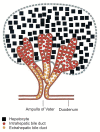Characterization of Intraductal Papillary Neoplasm of the Bile Duct with Respect to the Histopathologic Similarities to Pancreatic Intraductal Papillary Mucinous Neoplasm
- PMID: 30982236
- PMCID: PMC6860037
- DOI: 10.5009/gnl18476
Characterization of Intraductal Papillary Neoplasm of the Bile Duct with Respect to the Histopathologic Similarities to Pancreatic Intraductal Papillary Mucinous Neoplasm
Abstract
Intraductal papillary neoplasms of the bile duct (IPNBs) are known to show various pathologic features and biological behaviors. Recently, two categories of IPNBs have been proposed based on their histologic similarities to pancreatic intraductal papillary mucinous neoplasms (IPMNs): type 1 IPNBs, which share many features with IPMNs; and type 2 IPNBs, which are variably different from IPMNs. The four IPNB subtypes were re-evaluated with respect to these two categories. Intestinal IPNBs showing a predominantly villous growth may correspond to type 1, while those showing papillay-tubular or papillay-villous growth correspond to type 2. Regarding gastric IPNB, those with regular foveolar structures with varying numbers of pyloric glands may correspond to type 1, while those with papillary-foveolar structures with gastric immunophenotypes and complicated structures may correspond to type 2. Pancreatobiliary IPNBs that show fine ramifying branching may be categorized as type 1, while others containing many complicated structures may be categorized as type 2. Oncocytic type, which displays solid growth or irregular papillary structures, may correspond to type 2, while papillary configurations with pseudostratified oncocytic lining cells correspond to type 1. Generally, type 1 IPNBs of any subtype develop in the intrahepatic bile ducts, while type 2 IPNBs develop in the extrahepatic bile duct. These findings suggest that IPNBs arising in the intrahepatic ducts are biliary counterparts of IPMNs, while those arising in the extrahepatic ducts display differences from prototypical IPMNs. The recognition of these two categories of IPNBs with reference to IPMNs and their anatomical location along the biliary tree may deepen our understanding of IPNBs.
Keywords: Biliary anatomy; Cholangiocarcinoma; Counterpart; Intraductal papillary mucinous neoplasm of pancreas; Intraductal papillary neoplasm of bile duct.
Conflict of interest statement
No potential conflict of interest relevant to this article was reported.
Figures











References
-
- Nakanuma Y, Curado M-P, Franceschi S, et al. Intrahepatic cholangiocarcinoma. In: Bosman FT, Carneiro F, Hruban RH, Theise ND, editors. WHO of tumours of the digestive system. Lyon: International Agency for Research on Cancer; 2010. pp. 217–224.
-
- Albores-Saavedra J, Adsay NV, Crawford JM, et al. Carcinoma of the gallbladder and extrahepatic bile ducts. In: Bosman FT, Carneiro F, Hruban RH, Theise ND, editors. WHO classification of tumours of the digestive system. Lyon: International Agency for Research on Cancer; 2010. pp. 266–273.
Publication types
MeSH terms
LinkOut - more resources
Full Text Sources
Medical

